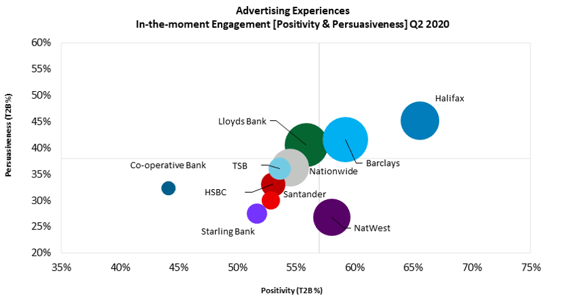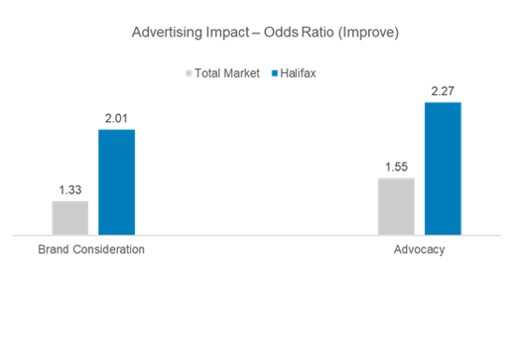-
Halifax has led the way in advertising comms during COVID-19. Its advertising has landed the best with customers and prospects, proving to be the most positive and persuasive banking advertising across the lockdown period.
Communicating during a crisis is vital for brands to demonstrate their values, at a time when customers need support the most. Using real-time experience tracking data, we quickly saw that Halifax led the retail banking sector with its advertising. During the main lockdown period, 66% of Halifax’s advertising experiences were fairly or very positive and 45% made people more likely to choose the brand in future (chart 1). This performance beat all other major banking competitors during the same time period.

-
Our data is collected in real-time, through our diary platform, allowing us to analyse consumer advertising receptivity and changes in banking habits on a weekly basis and in return providing guidance to banks at a time of disruption.
Responding to a Crisis
The Centres for Disease Control’s (CDC) Crisis and Emergency Risk Communication (CERC) sets out the key principles for communication during a public health emergency.
These principles are:
- Be first
- Be right
- Be credible
- Express empathy
- Promote action
- Show respect
These principles align with key findings from our weekly analysis and provide a suitable framework to understand the performance of Halifax’s advertising over the Coronavirus crisis period.
Lloyds and Barclays were first to react on TV, reworking and creating new COVID-19 related advertising a week into lockdown. However, Halifax was out early with a helpful Q&A style newspaper ad and was soon out with direct and informative TV advertising. Both ads put Halifax’s staff and helpful nature at the forefront.

Halifax was right with its advertising message, providing reassurance and support to customers. This helped to make customers feel safe but also portrayed Halifax as a bank that is there and cares for its customer. This led to advertising engagement among Halifax’s potential prospects as well as current customers.
Halifax's advertising was credible. People could believe the points the advertising made, using staff gave the comms more credibility and grounded the advertising in reality. The measures put forward, such as mortgage and credit card payment holidays, were clear and generated an overall helpful impression for Halifax. This contrasts with some other banks over this period which have utilized more emotionally engaging advertising, which hasn’t been as successful.
The tone of Halifax’s advertising expressed empathy. It was down to earth, understanding and matched the mood of the nation at the time. Halifax showed it was understanding towards people’s current situation, being “there for people wherever they need”.
Halifax did a good job at promoting action. Across channels, Halifax gave clear advice and instructions to customers who were looking for help and it put these measures at the front of its comms. At this time action was key, with customers looking for information and advice and wanting banks to be clear.
Finally, Halifax showed respect through open and honest communication. Audiences were understanding during this time and were looking to be heard and interacted with.
Halifax has really hit the mark with its comms during lockdown and as a result the Halifax brand has benefited. Results from our Experience Maximizer analysis of the retail banking sector in Q2 show that, Halifax's advertising performed better compared with the market average for improving consideration. Further, Halifax’s advertising improves brand advocacy, again outperforming the total market impact (chart 2).

-
In Summary
At a time of crisis audiences are looking for banks to be proactive, give clear advice and actions as to the support they are offering to customers. It is important for banks to be present, not to go dark, at a time of crisis. Banks need to put forward their voice and show their true value of being there for their customers.
Catherine Kehoe, Chief Customer Officer at Lloyds Banking Group, said in a recent article that "the most successful modern brands are defined by an alchemy between strategy, experience and communications" . This sense of alchemy clearly comes through in Halifax’s recent communications.
During the lockdown period, Halifax increased its relative presence in the market, a strategy to maintain visibility. Halifax’s communication was particularly good at being credible and action-orientated, whilst also being empathetic and respectful to audiences.
As a result, Halifax benefited from a receptive and engaged audience, building consideration and advocacy for the brand in the longer run.
Mark Thompson, Experience Director, MESH Experience

